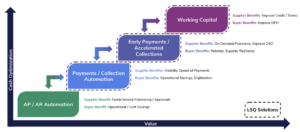Author
Andy Cagle
Share
Moving Up the Maturity Curve: AP Automation to Working Capital
In the previous blog in this series, we discussed the payments-to-working capital maturity model and how to determine where you align in terms of maturity: reactive, responsive, proactive and innovative. The question we often get once a company determines their maturity level is, “how do I move up the maturity curve?”

Moving up the Maturity Curve
First and foremost, moving up the maturity curve requires an executive sponsor. Many times, payments automation is supported by the chief procurement officer, as payments to suppliers are closely aligned to supplier relationship management. Many times, the executive sponsor may be the chief financial officers (CFOs), as payables and treasury typically report up through the finance organization. Regardless of which organization sponsors the efforts, close collaboration and alignment must be made between these two organizations to drive the change management and avoid the “whack-a-mole” game, where automating a process on one side raises challenges on another side.
Steps you can take to move from reactive to responsive:
- Automation of invoicing approvals is key to maturing the payments-to-working capital process. Implement an AP automation solution to digitize your invoices and turn text into data for analysis and processing.
- Start identifying specific people within your organization to formally assume responsibilities for various aspects of your AP automation and working capital initiatives. This could include an executive sponsor, as well as IT resources and business subject matter experts (SMEs).
- Start to operationalize your invoicing methods (i.e., standardize terms, implement electronic invoicing and payments).
- Identify opportunities where increased working capital will greatly impact the strategic growth of the business. This could be investments in new equipment, an upgraded technology stack, or research and development.
- Learn more about AP automation and working capital and the benefits of automation in customer case studies:
Steps you can take to move from responsive to proactive:
Reactive and responsive levels are typically tactical levels of maturity. You’re doing something because it must be done, but do not view it as strategic or able to provide competitive differentiation or contribution to the bottom or top line. Moving from responsive to proactive is the most difficult for most companies because it requires a shift in mindset from a “must do tactical operational” thinking to a “how can we take what we must do and make it a competitive differentiation” thinking — a more strategic mindset.
- Identify an executive sponsor to change the mindset of accounts payable from an operational “must-have” to a strategic “key player in working capital management.”
- Optimize your organizational processes and personnel to make AP and working capital not just a part of your business, but core to the success of your business.
- Determine the appropriate uses for payment tools such as: check/ACH/wire, commercial cards, payment networks, and supplier discounts and how they align to your working capital strategic outcomes.
- Build the business case to implement automated working capital programs between your company and your suppliers. LSQ offers a working capital calculator to help you build your business case for working capital.
- Talk to your suppliers to get them to partner with you on your payments and working capital initiatives. You may be surprised how much your suppliers want to deepen their partnership with your business.
- Invest in technical and data infrastructure to deliver faster, more impactful services, such as business intelligence and payments/working capital insights.
Steps you can take to move from proactive to innovative:
Moving from proactive to Innovative is typically the easiest transition to make, primarily because the organization views these processes and activities as strategic to the business and know they contribute innovation that delivers a competitive differentiation to the business.
- Expand your collaborative channel with your trading partners (both upstream and downstream) to implement working capital solutions that secure your entire supply chain.
- Develop payment and working capital solutions aligned to your supplier segmentation. It is not a one-size-fits-all solution and not all your trading partners are at the same level of maturity.
- Drive payments and working capital best practices to your trading partners.
- Track, measure and share your successes and continue to learn and adopt from your failures.
Hopefully you have enjoyed this blog series and not understand how Esker and LSQ’s partnership from AP automation to working capital optimization are a clear technology solution to drive your payments to working capital maturity. For any additional questions, reach out to Mike Magilor at LSQ or visit lsq.com or esker.com.
Stay in the loop




![LSQ-merger_Logo_Stacked_white[84]](https://www.lsq.com/wp-content/uploads/2025/02/LSQ-merger_Logo_Stacked_white84-200x97.png)
